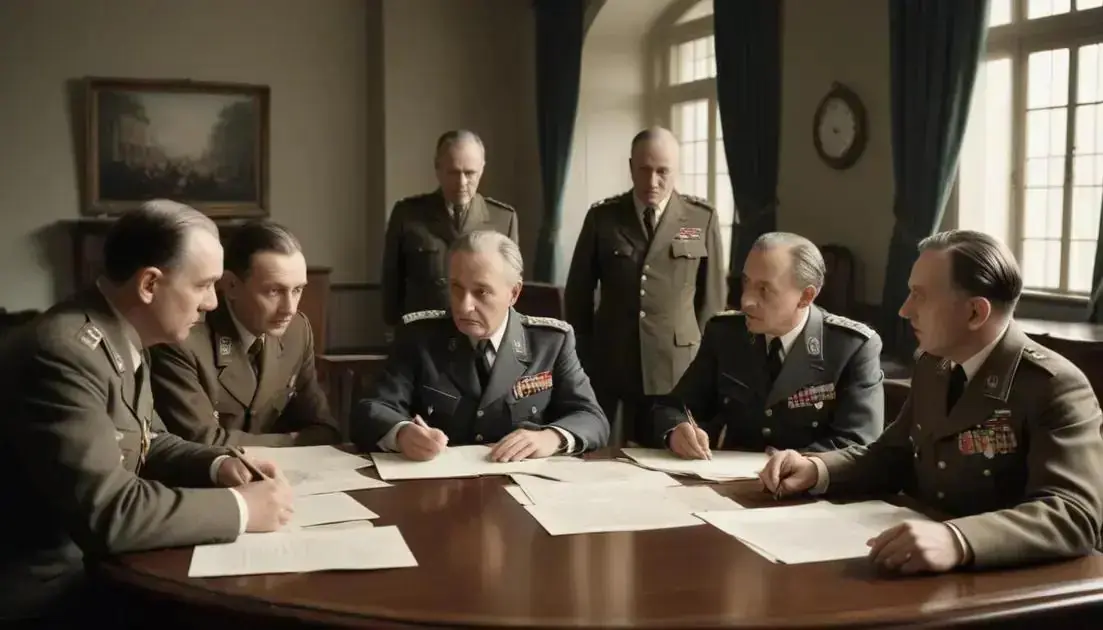
Wannsee Conference: Bureaucratizing the Holocaust
The Wannsee Conference, held on January 20, 1942, was a significant meeting of Nazi officials where they planned the “Final Solution” to exterminate the Jewish population in Europe. Key figures like Reinhard Heydrich and Adolf Eichmann led discussions on logistics, deportation, and systematic extermination. The impact of this conference was profound, transitioning from persecution to organized genocide. Remembering this event is crucial for Holocaust education and awareness, promoting tolerance and fighting against bigotry in society today.
The Holocaust is one of the darkest chapters in human history, and the Wannsee Conference stands as a grim cornerstone of its bureaucratic execution. Have you ever wondered how such a devastating plan was put into motion?
Introduction to the Wannsee Conference
The Wannsee Conference took place on January 20, 1942. It was a meeting of senior Nazi officials who gathered to discuss the implementation of the “Final Solution.” This plan aimed to systematically exterminate the Jewish population in Europe. The meeting wasn’t just about hatred; it was a shocking example of bureaucracy applied to genocide.
Who Was Involved?
Important figures attended the Wannsee Conference, including Reinhard Heydrich and Adolf Eichmann. These men were key in organizing the logistics of mass deportation and murder. Their discussions revealed how deeply embedded the plans for the Holocaust were within the Nazi regime.
The Agenda of the Meeting
During the conference, attendees reviewed the number of Jews in various European countries. They planned how to coordinate the efforts of different government agencies in exterminating Jews. This marked a significant step towards implementing state-sponsored murder.
Why Is This Meeting Significant?
The Wannsee Conference is significant because it showed the chilling efficiency of the Nazis. They transformed genocide into a bureaucratic process. This event is a reminder of how ordinary people can become part of horrific decisions.
Understanding the Wannsee Conference helps us remember the magnitude of the Holocaust. It teaches us about the dangers of inaction against hatred and bigotry. Each detail matters when we look back on this dark time.
Key Figures Involved
The Wannsee Conference included many key Nazi officials who played crucial roles in the Holocaust. Reinhard Heydrich was one of the main organizers. He led the meeting and set the agenda. Heydrich, known as the “Butcher of Prague,” was notorious for his brutal methods.
Adolf Eichmann
Adolf Eichmann was another significant figure at the conference. He was responsible for managing the logistics of the Final Solution. Eichmann’s job included arranging the transportation of Jews to concentration camps.
Other Participants
Alongside Heydrich and Eichmann, several other officials attended the meeting. They came from various government offices, like the SS, the Gestapo, and the Foreign Office. Each person had a role in enforcing Nazi policies.
Their participation showed how deeply the Nazi regime was involved in the plan to exterminate Jews. It wasn’t just a few bad apples; it was a system of many individuals working together in a horrific plan.
Each figure brought specific expertise and authority to the meeting. Their collective decisions marked a turning point in history, leading to unimaginable suffering for millions.
The Agenda of the Meeting
The agenda of the Wannsee Conference was chilling and precise. The main goal was to discuss the “Final Solution” for the Jewish population in Europe. The officials wanted to find ways to coordinate their efforts effectively.
Key Points Discussed
One main point was the number of Jews in different countries. They compiled lists and statistics to understand the scope of their plan. This included details on Jewish populations in Germany and occupied territories.
Logistical Considerations
The meeting also focused on logistics. They needed a plan for transporting large numbers of people. Discussions included how to use existing transportation systems to move Jews to camps.
Coordination Between Agencies
Another important topic was coordination between various government departments. Officials from the SS, police, and foreign offices needed to work together. They discussed how to streamline this cooperation.
The agenda laid the groundwork for implementing a horrific plan. It turned genocide into a methodical process carried out by the state.
Impact on the Holocaust
The Wannsee Conference had a significant impact on the Holocaust. It marked a key moment in the transition from persecution to systematic murder. The decisions made there set in motion plans for the mass extermination of Jews.
Systematic Extermination
Before the conference, there were already violent acts against Jews. However, the meeting formalized these actions into a coordinated effort. It established a clear goal to eliminate Jews from Europe.
Implementation of the Final Solution
The conference helped organize the “Final Solution.” This was not just an idea; it became a plan with structure and support from government agencies. Nazi officials discussed methods, logistics, and cooperation to make this horrific goal a reality.
Wider Implications
The impact extended beyond what was discussed in the meeting. It set a precedent for how genocide could be organized systematically. The bureaucratic approach made it easier for many to participate without questioning their actions.
In every country where the Nazis invaded, the consequences were devastating. The conference led to the deaths of millions and marked one of history’s darkest periods. It serves as a reminder of the dangers of hatred and intolerance.
Legacy and Remembrance
The legacy of the Wannsee Conference is powerful and serves as a reminder of the past. It highlights the dangers of hatred and intolerance. Remembering this event is vital to prevent similar tragedies in the future.
Holocaust Education
Education about the Holocaust is essential. Schools and communities teach about the Holocaust to ensure people remember the lessons learned. By sharing stories and experiences, we help keep the memory alive.
Memorials and Commemorations
Many memorials exist to honor victims. These places serve as reminders of the lives lost and the importance of standing against hate. Annual commemorations also take place, bringing people together to remember.
Continued Relevance
The issues raised by the Wannsee Conference remain relevant today. Hatred and prejudice can still be found in society. By remembering history, we can challenge these behaviors and promote tolerance and understanding.
Preserving the memory of the Holocaust urges us to fight against injustice. Each story shared strengthens our commitment to a more humane world. The legacy of the conference continues, encouraging reflection and action.
Conclusion
In conclusion, the Wannsee Conference was a pivotal moment in history, shaping the course of the Holocaust. Understanding its impact helps us remember the tragic lessons from the past. It’s important to educate others about this dark period to prevent such atrocities from happening again.
By honoring the victims through memorials and education, we keep their memories alive. The legacy of the Holocaust reminds us of the dangers of hatred and discrimination. Together, we can work towards a more tolerant and compassionate world.
Let’s use these lessons to inspire change and promote understanding, ensuring that history does not repeat itself. Each of us has a role to play in fostering peace and fighting against bigotry.


